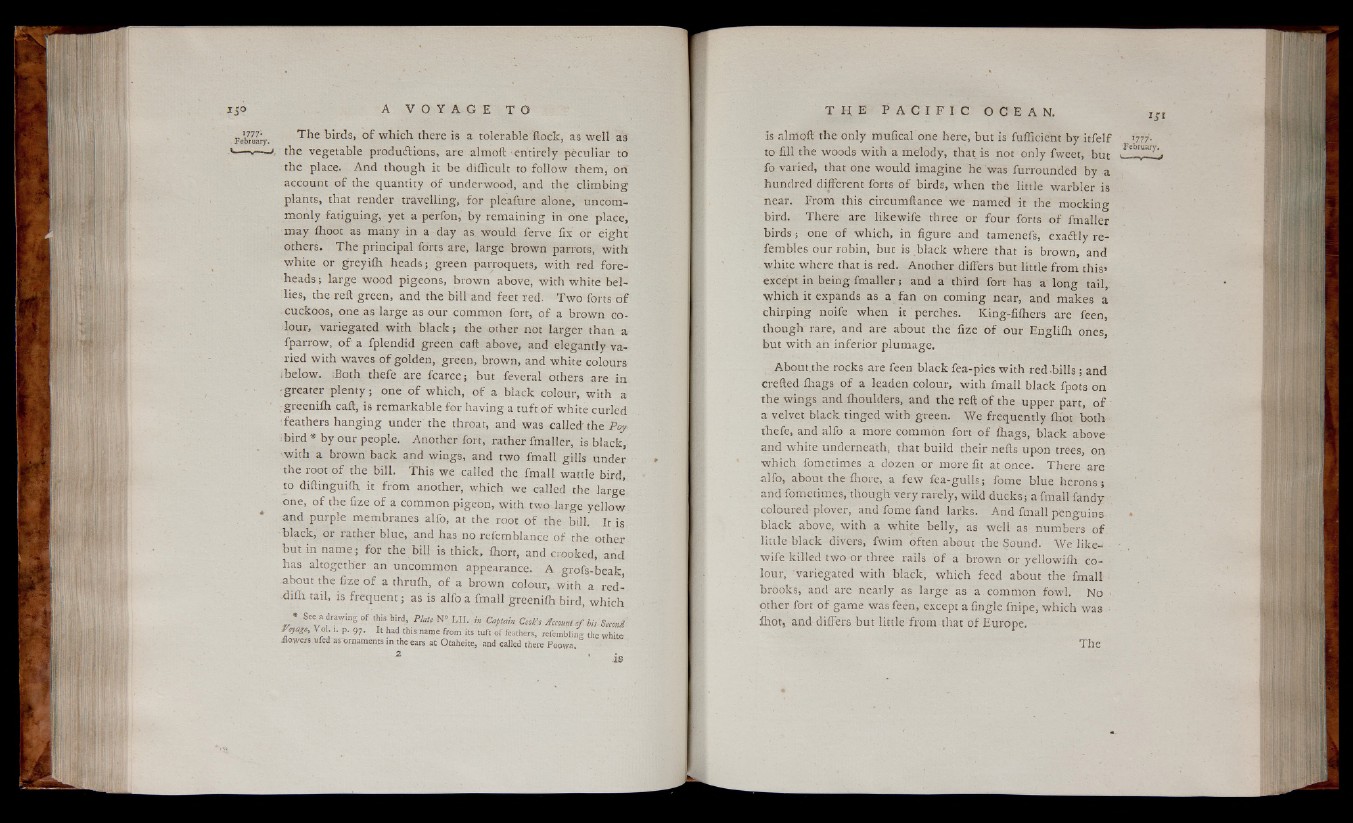
February. The hirds, of which there is a tolerable flock, as well as
.v— v— j the vegetable productions, are almoft entirely peculiar to
the place. And though it be difficult to follow them, on
account of the quantity of underwood, and the climbing
plants, that render travelling, for pleafure alone, uncommonly
fatiguing, yet a perfon, by remaining in one place,
may ihoot as many in a day as would ferve fix or eight
others. The principal forts are, large brown parrots, with
white or greyifh heads; green parroquets, with red foreheads
; large wood pigeons, brown above, with white bellies,
the reft green, and the bill and feet red. Two forts of
cuckoos, one as large as our common fort, of a brown colour,
variegated with black; the other not larger than a
fparrow, o f a fplendid green caft above, and elegantly varied
with waves of golden, green, brown, and white colours
, below. .Both thefe are fcarce; but feveral others are in
greater plenty; one of which, of a black colour, with a
greenifh caft, is remarkable for having a tuft of white curled
feathers hanging under the throat, and was called' the Poy
bird * by our people. Another fort, rather fmaller, is black,
with a brown back and wings, and two fmall gills under
the root of the bill. This we called the fmall wattle bird,
to diftinguifh. it from another, which we called the large
one, of the fize of a common pigeon, with two large yellow
and purple membranes alfo, at the root of the bill. It is
black, or rather blue, and has no refemblance of the other
but in name; for the bill is thick, ihort, and crooked, and
has altogether an uncommon appearance. A grofs-beak,
about the fize of a thruih, of a brown colour, with a red-
diih tail, is frequent; as is alfo a fmall greeniih bird, which
* See a drawing of this bird, F t e N " LII. | Captain Cook's Account of, his Scconi
Voyage, V o l . p. 97. It had this name from its tuft of feathers, refembling the white
flowers ufed as ornaments in the ears at Otaheite, and called there Poowa.
2 ’ is
is almoft the only mufical one here, but is fufficient by itfelf
to fill the woods with a melody, that is not only fweet, but
fo varied, that one would imagine he was furrounded by a
hundred different forts of birds, when the little warbler is
near. From this circumftance we named it the mocking
bird. There are likewife three or four forts of fmaller
birds ; one of which, in figure and tamenefs, exatftly re-
fetnbles our robin, but is .black where that is brown, and
white where that is red. Another differs but little from this»
except in being fmaller; and a third fort has a long tail,,
which it expands as a fan on coming near, and makes a
chirping noife when it perches. King-fiihers are feen,
though rare, and are about the fize of our Engliih ones,
but with an inferior plumage.
Aboutthe rocks are feen black fea-pies with red bills; and
crefted fhags of a leaden colour, with fmall black fpots on
the wings and ihoulders, and the reft of the upper part, of
a velvet black tinged with green. We frequently fliot both
thefe, and alfo a more common fort of fhags, black above
and white underneath, that build their nefts upon trees, on
which fometimes a dozen or more fit at once. There are
alfo, about the fhore, a few fea-gulls; fome blue herons;
and fometimes, though very rarely, wild ducks; a fmall fandy
coloured plover, and fome fand larks. And fmall penguins
black above, with a white belly, as well as numbers of
little black divers, fwim often about the Sound. We likewife
killed two or three rails of a brown or yellowiih colour,
'variegated with black, which feed about the fmall
brooks, and are nearly as large as a common fowl. No ■ .
other fort of game was feen, except a fingle fnipe, which was
fhot, and differs but little from that of Europe.
The